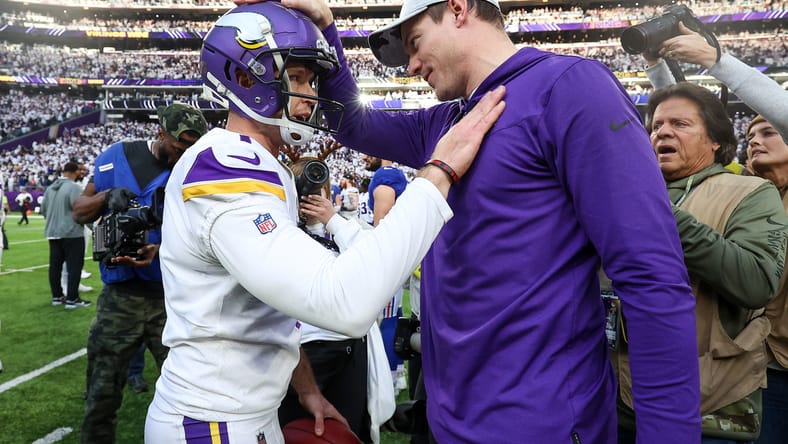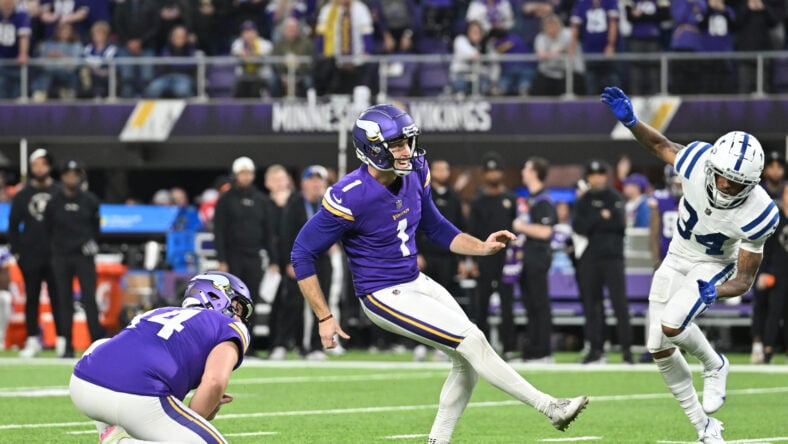The Sea Change That Led Us To Greg Joseph’s Latest Game Winner

Greg Joseph was given the NFL’s Special Teams Player of the Week Award again this week, following his breathtaking (and I do mean that literally) 61-yard field goal as time expired to beat the New York Giants 27-24 on Christmas Eve. It was his second such award, having earned the honor following his game-winner against the Saints in London in Week 4. Joseph has now kicked game-winners five times this season—tying John Kasay (2003) and Jan Stenerud (1983) for the most ever.
Furthermore, it was his tenth career field goal from 50 yards or more—third most in Vikings’ team history behind Blair Walsh (24 over five seasons with Minnesota) and Ryan Longwell (11 in 6 years). Joseph is nearing the end of his second year in purple.
It was, of course, only a few short weeks ago that some fans and media pundits were calling for Joseph’s head, having started the season performing very well in field goal situations, but mysteriously missing five extra points after missing four more in 2021. Those misses were certainly painful when they occurred, but I’d trade five game-winners for five missed extra points anytime, no questions asked.
Watching Greg Joseph perform at a high level this year has gotten me thinking back to my youth, when the Vikings dominated the old “Black & Blue” Central Division in the seventies, racking up four Super Bowl appearances. They were the glory years that my elementary school-self drank happily en route to a lifetime of Viking fandom, never dreaming that those days would never come again.
Ah, the naivete of a young child. And the futility of a Viking fan, no matter the age.

In harking back to that era, I wasn’t pining for an earlier time, per se, nor was I waxing nostalgic about “the good old days”. I was simply pondering how far the Vikings, and the NFL, have come in regard to placekicking, between today’s abbreviated Greg Joseph Era and the days of the sixties and seventies, when one man bridged the eras between Straight-On kicking and the modern “Soccer-Style” approach—and led the Vikings in scoring for each of his fifteen season, including all four of those Super bowl years: Fred Cox.
“Steady Freddy” made his debut in 1963, kicking the way every other placekicker kicked the football in those days—lining up directly behind the center and two steps behind his holder. As Michael Farber of Sports Illustrated so eloquently described it, it was a time when “America took its whiskey and field goals straight.”
The NFL in the early sixties was still in many ways a work in progress, with a certain playground mentality still pervasive in how the game was played. Many teams had one man handling both punting and kicking duties, including NFL scoring leader Don Chandler, and Cox himself. The Green Bay Packers had Hall of Fame halfback Paul Hornung handle kicking, and, when he was hurt in ’62 and suspended in ’63, turned to another Hall of Famer, guard Jerry Kramer for the job. Kramer would finish 4th in the NFL in scoring in 1963 while leading the league in field goal percentage at 82%, all while anchoring the Packers offensive line. The rookie Cox was 10th. The norm among professional kickers at the time was a 50% success rate on field goals – with a typical game featuring two tries and one make for each team. But that was about to change.
The American Football League had been founded just three years earlier, and the upstart competitor to the NFL was fond of doing things radical and different. In their first season of 1960, they scheduled 14 games per season, prompting the NFL to change the following year. The AFL instituted the 2-point conversion, something the NFL refused to do even after the AFL/NFL merger—the 2-pointer was relegated to college football only until it reappeared in the NFL in 1994. And, in 1964 the AFL’s Buffalo Bills drafted Hungarian kicker Pete Gogolak, a “soccer-style” kicker who began a trend that eventually became the norm.
Pete Gogolak was soon joined by his brother Charlie, who was signed by the NFL’s Washington Redskins. Their presence in the league began as an oddity, but then began sparking debate between old-schoolers and science supporters. At least some things haven’t changed.
The Gogolaks were somewhat erratic, and though they met the eye test for being able to kick for distance, the old guard maintained that the Straight On approach was more reliable. Exhibit “A” to support this theory could have been Pete Gogolak’s 58% career field goal percentage, versus “Steady” Freddy Cox’ 62%. The counterargument was that was Gogolak, and his emerging peers were emboldening their coaches to try more, longer field goals, which would naturally depress the field goal percentage but eventually lead to more wins with more longer kicks sailing through the uprights.

The pro-science sector pointed to the far greater acceleration of the foot achieved through a sidewinding approach, combined with greater margin for error. Former New York Jets coach Weeb Ewbank told the Chicago Tribune, ”I sat with one of the Gogolak boys on an airplane one time, he talked quite a bit about the margin of error. I coached one of the best kickers ever in Lou Groza. He kicked them with his toe and he was very good. But he missed a lot, too. His kicks would go off to the side. Well, Gogolak said the margin of error with a straight kicker is the width of the toe. The margin of error with the soccer-style kicker is the entire instep of the foot.”
Two more AFL field goal kickers came along in the coming years to settle that score once and for all—first Stenerud, from Norway, joined the Kansas City Chiefs in 1967, converting two 50+ yard attempts apiece in each of his first three seasons and leading his league in field goal percentage in ’68 and ‘69; then Garo Yepremian, a native of Cyprus and a Detroit Lions washout, joined the Miami Dolphins and promptly led the league in FGP at 76% while converting 11 of 16 from 40+ yards, and converted a then-record 3 from 50+ in the Dolphins’ perfect 17-0 season of 1972. Both players kicked for the winning team against Cox and the Vikings in Super Bowls.
The tide had turned, and the seventies were the beginning of the long reign of the sidewinder. By the time the Vikings lost their fourth and final Super Bowl in early 1977, only Cox and a handful of others remained. Cox retired the following season with a franchise-record 1,365 points, a record that still stands today, and is more than twice the total of runner-up Cris Carter’s 670. In between, Cox kicked in a Pro-Bowl, led the league in field goals made three times (’65, ’69, and ’70–when he also set the then-NFL record with 30 made field goals) and led in percentage for 1970 at 69%, when the league average stood at 52%.
Greg Joseph may most appreciate his 11-year run from 1963-73 when he missed just three extra points, two in the 1964 season, including a perfect 100% in 8 of 9 years from ’65-73. Of course, PATs during that era were snapped from the two yard line, with the goal posts sitting at that goal line rather than the end line, so take that last set of stats with a grain of salt. Cox passed away in 2019 at the age of 80, missed by fans and former teammates alike.
As for the league as a whole, the evolution became complete in 1986 when Mark Moseley, the last of the Straight-On kickers, retired from Washington. Moseley had won a Super Bowl, led the NFL in field goals made four times, and became the only pure kicker ever to be named NFL MVP.
Besides their Straight-On style and high degree of success as placekickers, Cox and Moseley have another common thread—both have had notable off-the-field business success. Cox famously invented the Nerf Football—for decades a godsend to grade-school kids with small hands but a strong desire to fling backyard touchdown passes—in 1973, earning millions. Moseley joined an Arlington, VA burger chain in the early 00’s called Five Guys as Director of Franchise Development—growing the company from 5 restaurants into a 1,600-store burger empire.
Meanwhile, the NFL grew, morphed, and evolved into America’s favorite and top-rated sport, a Sunday obsession, and a haven for highly talented soccer-style placekickers. Justin Tucker has become the most successful at this craft of anyone all-time, and he and the rest of his contemporaries have made those 1960s and 1970s era stats seem innocent and quaint. Field goals are made at twice the volume as the old ’60s standard, and leaguewide field goal percentage has improved from 49.6% in 1963 to an all-time high 89.2% thus far this season. And as for distance, they’ve taken 50+, and even 60+ yard kicks from a novelty to a weekly feat around the NFL.
In 1963, the longest kick of the season was Chandler’s boot of 53 yards, with the longest of the entire decade—54 yards—coming the season prior by the legendary George Blanda. There were 3 successful kicks of 50+ across the entire NFL that year; thus far in 2022, the league has averaged 9 per week.
Taking it up a notch, in the 70’s, 80’s, 90’s and 00’s, a 60-yard field goal was made roughly once every 9-10 seasons. In the last decade and a half, one more change has hit the NFL that has changed kicking, probably forever: analytics. Coaching decisions are made in a different way today than they were decades ago. Back then, there was the mythical “book”, as in “he made that decision ‘by the book’”. Now there’s an actual book-or, more accurately, a database. Analytics tell us that a kicker is not likely to make a kick of over 60 yards, but it also considers the likelihood of winning games after the kick/no-kick choice is made, given the circumstances.
Turns out, it’s not at all dumb to just “give it a try”, despite the low odds, late in a game where previously a coach might take the option of punting and going for a quick three and out. Bottom line: more 60-yard kicks are being tried…and more are being made, than ever before. Since 2009, there’s been at least one 60-yarder each year except 2015. Last year, Tucker set a new record at 66 yards. This year, NFL kickers are 5-for-13 in 60+ field goal tries.
The evolution of the field goal kicker is now complete—at least until the next radical change takes place. Fred Cox would hardly recognize it—but then again, Justin Tucker or Greg Joseph would hardly recognize the world that Cox stepped into back in 1963, at Metropolitan Stadium in Bloomington, Minnesota, just a few weeks before President Kennedy was killed, and a few years before a man was put on the moon. Time marches on, and the impossible becomes possible.
One day, perhaps, rocket-powered Nerf Footballs will be used for field goals in the NFL, and a 90-yard three-pointer will clinch a Super Bowl victory for the Vikings. Perhaps.

